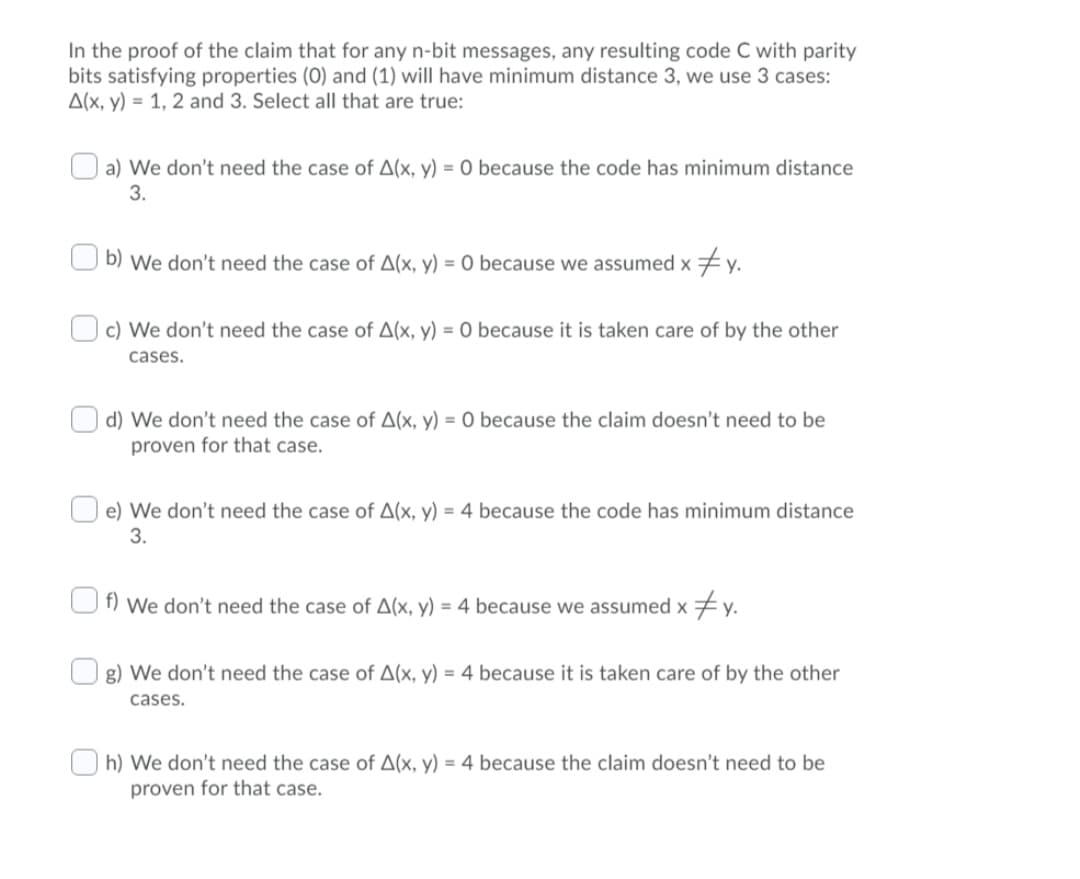In the proof of the claim that for any n-bit messages, any resulting code C with parity bits satisfying properties (0) and (1) will have minimum distance 3, we use 3 cases: A(x, y) = 1, 2 and 3. Select all that are true:
In the proof of the claim that for any n-bit messages, any resulting code C with parity bits satisfying properties (0) and (1) will have minimum distance 3, we use 3 cases: A(x, y) = 1, 2 and 3. Select all that are true:
Computer Networking: A Top-Down Approach (7th Edition)
7th Edition
ISBN:9780133594140
Author:James Kurose, Keith Ross
Publisher:James Kurose, Keith Ross
Chapter1: Computer Networks And The Internet
Section: Chapter Questions
Problem R1RQ: What is the difference between a host and an end system? List several different types of end...
Related questions
Question

Transcribed Image Text:In the proof of the claim that for any n-bit messages, any resulting code C with parity
bits satisfying properties (0) and (1) will have minimum distance 3, we use 3 cases:
A(x, y) = 1, 2 and 3. Select all that are true:
a) We don't need the case of A(x, y) = 0 because the code has minimum distance
3.
b) We don't need the case of A(x, y) = 0 because we assumed x # y.
c) We don't need the case of A(x, y) = 0 because it is taken care of by the other
cases.
d) We don't need the case of A(x, y) = 0 because the claim doesn't need to be
proven for that case.
e) We don't need the case of A(x, y) = 4 because the code has minimum distance
3.
f) We don't need the case of A(x, y) = 4 because we assumed x y.
g) We don't need the case of A(x, y) = 4 because it is taken care of by the other
cases.
h) We don't need the case of A(x, y) = 4 because the claim doesn't need to be
proven for that case.
Expert Solution
This question has been solved!
Explore an expertly crafted, step-by-step solution for a thorough understanding of key concepts.
Step by step
Solved in 2 steps with 4 images

Recommended textbooks for you

Computer Networking: A Top-Down Approach (7th Edi…
Computer Engineering
ISBN:
9780133594140
Author:
James Kurose, Keith Ross
Publisher:
PEARSON

Computer Organization and Design MIPS Edition, Fi…
Computer Engineering
ISBN:
9780124077263
Author:
David A. Patterson, John L. Hennessy
Publisher:
Elsevier Science

Network+ Guide to Networks (MindTap Course List)
Computer Engineering
ISBN:
9781337569330
Author:
Jill West, Tamara Dean, Jean Andrews
Publisher:
Cengage Learning

Computer Networking: A Top-Down Approach (7th Edi…
Computer Engineering
ISBN:
9780133594140
Author:
James Kurose, Keith Ross
Publisher:
PEARSON

Computer Organization and Design MIPS Edition, Fi…
Computer Engineering
ISBN:
9780124077263
Author:
David A. Patterson, John L. Hennessy
Publisher:
Elsevier Science

Network+ Guide to Networks (MindTap Course List)
Computer Engineering
ISBN:
9781337569330
Author:
Jill West, Tamara Dean, Jean Andrews
Publisher:
Cengage Learning

Concepts of Database Management
Computer Engineering
ISBN:
9781337093422
Author:
Joy L. Starks, Philip J. Pratt, Mary Z. Last
Publisher:
Cengage Learning

Prelude to Programming
Computer Engineering
ISBN:
9780133750423
Author:
VENIT, Stewart
Publisher:
Pearson Education

Sc Business Data Communications and Networking, T…
Computer Engineering
ISBN:
9781119368830
Author:
FITZGERALD
Publisher:
WILEY